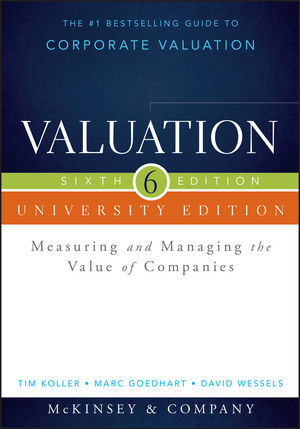
Measuring and Managing the Value of Companies (Valuation)
Authors: McKinsey & Company Inc., Tim Koller, Marc Goedhart, David Wessels
Year: 2015
Month: September
Publisher: John Wiley
ISBN: 978-1-118-87370-0
Valuation is the single best guide of its kind, helping financial professionals worldwide excel at measuring, managing, and maximizing shareholder and company value. This new sixth edition provides insights on the strategic advantages of value-based management, complete detailed instruction, and nuances managers should know about valuation and valuation techniques as applied to different industries, emerging markets, and other special situations.
Valuation lies at the crossroads of corporate strategy and finance. In today’s economy, it has become an essential role — and one that requires excellence at all points. This guide shows you everything you need to know, and gives you the understanding you need to be effective.
· Estimate the value of business strategies to drive better decision making
· Understand which business units a corporate parent is best positioned to own
· Assess major transactions, including acquisitions, divestitures, and restructurings
· Design a capital structure that supports strategy and minimizes risk
As the valuation function becomes ever more central to long- and short-term strategy, analysts and managers need an authoritative reference to turn to for answers to challenging situations. Valuation stands ahead of the field for its reputation, quality, and prestige, putting the solutions you need right at your fingertips.
Table of Contents
About the Authors ix
Preface xi
Acknowledgments xv
Part One Foundations of Value
1 Why Value Value? 3
2 Fundamental Principles of Value Creation 17
3 Conservation of Value and the Role of Risk 35
4 The Alchemy of Stock Market Performance 49
5 The Stock Market Is Smarter Than You Think 65
6 Return on Invested Capital 93
7 Growth 115
Part Two Core Valuation Techniques
8 Frameworks for Valuation 135
9 Reorganizing the Financial Statements 165
10 Analyzing Performance 201
11 Forecasting Performance 221
12 Estimating Continuing Value 247
13 Estimating the Cost of Capital 269
14 Moving from Enterprise Value to Value per Share 301
15 Analyzing the Results 321
16 Using Multiples 331
17 Valuation by Parts 353
Part Three Advanced Valuation Techniques
18 Taxes 373
19 Non-operating Items, Provisions, and Reserves 387
20 Leases and Retirement Obligations 405
21 Alternative Ways to Measure Return on Capital 423
22 Inflation 445
23 Cross-Border Valuation 459
24 Case Study: Heineken 481
Part Four Managing for Value
25 Corporate Portfolio Strategy 525
26 Performance Management 543
27 Mergers and Acquisitions 565
28 Divestitures 593
29 Capital Structure, Dividends, and Share Repurchases 611
30 Investor Communications 643
Part Five Special Situations
31 Emerging Markets 667
32 Valuing High-Growth Companies 691
33 Cyclical Companies 705
34 Banks 713
35 Flexibility 741
Appendix A Discounted Economic Profit Equals Discounted Free Cash Flow 775
Appendix B Derivation of Free Cash Flow, Weighted Average Cost of Capital, and Adjusted Present Value 781
Appendix C Levering and Unlevering the Cost of Equity 787
Appendix D Leverage and the Price-to-Earnings Multiple 795
Appendix E Other Capital Structure Issues 799
Appendix F Technical Issues in Estimating the Market Risk
Premium 805
Index 809
